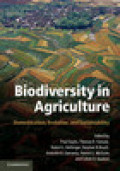
Biodiversity in agriculture: domestication, evolution, and sustainability
Gepts, Paul
Famula, Thomas R.
Bettinger, Robert L.
Brings together research from a range of fields to address key questions relating to agriculture: its origins and long-term sustainability. Bringing together research from a range of fields including anthropology, archaeology and ecology, this book addresses key questions relating to agriculture. It highlights how these topics can be applied to our understanding of contemporary agriculture, its long-term sustainability and the development of new crops and varieties. Bringing together research from a range of fields including anthropology, archaeology and ecology, this book addresses key questions relating to agriculture. It highlights how these topics can be applied to our understanding of contemporary agriculture, its long-term sustainability and the development of new crops and varieties. The introduction of plant and animal agriculture represents one of the most important milestones in human evolution. It contributedto the development of cities, alphabets, new technologies, and ultimately to civilizations, but it has also presented a threat to both human health and theenvironment. Bringing together research from a range of fields including anthropology, archaeology, ecology, economics, entomology, ethnobiology, genetics and geography, this book addresses key questions relating to agriculture. Why did agriculture develop and where did it originate? What are the patterns of domestication for plants and animals? How did agroecosystems originate and spread from their locations of origin? Exploring the cultural aspects of the development of agricultural ecosystems, the book also highlights how these topics can be applied to our understanding of contemporary agriculture, its long-term sustainability, the co-existence of agriculture and the environment, and the development of new crops and varieties. INDICE: List of contributors; Foreword Bruce D. Smith; Acknowledgments; Introduction. The domestication of plants and animals: ten unanswered questions Paul Gepts, Robert Bettinger, Stephen Brush, Ardeshir Damania, Thomas Famula, Patrick McGuire and Calvin Qualset; 1. The local origins of domestication Jared Diamond; Part I. Early Steps in Agricultural Domestication: 2. Evolution of agro-ecosystems: biodiversity, origins and differential development David R. Harris; 3. From foraging to farming in western and eastern Asia Ofer Bar-Yosef;4. Predomestic cultivation during the late Pleistocene and early Holocene in the Northern Levant George Willcox; 5. New archaeobotanical information on plant domestication from macro-remains: tracking the evolution of domestication syndRome traits Dorian Q. Fuller; 6. New archaeobotanical information on early cultivation and plant domestication involving microplant remains Dolores R. Piperno; 7. How and why did agriculture spread? Peter Bellwood; 8. California Indian proto-agriculture: its characterization and legacy M. Kat Anderson and Eric Wohlgemuth; Part II. Domestication of Animals and Impacts on Humans: 9. Pathways to animal domestication Melinda A. Zeder; 10. Genetics of animal domestication Leif Andersson; 11. Genome-wide approaches for the study of dog domestication Bridgett M. vonHoldt, Melissa M. Gray and Robert K. Wayne; 12. Malaria and rickets represent selective forces for the convergent evolution of adult lactase persistence Loren Cordain, Mathew S. Hickley and Kami Kim; Part III. Issues in Plant Domestication:
- ISBN: 978-0-521-76459-9
- Editorial: Cambridge University
- Encuadernacion: Cartoné
- Páginas: 630
- Fecha Publicación: 23/02/2012
- Nº Volúmenes: 1
- Idioma: Inglés
